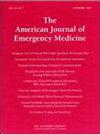在急诊室出院时的愤怒会增加4个月大的慢性疼痛风险。
IF 2.2
3区 医学
Q1 EMERGENCY MEDICINE
引用次数: 0
摘要
目的:探讨疼痛、压力和愤怒、悲伤、恐惧、后悔等负面情绪对急诊科(ED)住院4个月后慢性疼痛持续或发展的影响。方法:对641例急症患者的soft IV临床试验资料进行分析。出院时对疼痛、压力和负面情绪进行评估,然后将其分为非严重和严重。有慢性疼痛史的患者被纳入分析。4个月时的慢性疼痛采用二元是/否问题进行评估,其预测因素采用多变量逻辑回归,并根据统计显著性进行变量选择。结果:在ed入院后4个月,35.1%的患者报告慢性疼痛。正如预期的那样,既往的慢性疼痛史是一个强有力的预测因素。在没有慢性疼痛史的患者中,出院时报告严重愤怒的患者发生慢性疼痛的风险几乎是其三倍(OR = 2.8, 95% CI: 1.4-5.6)。此外,因外伤性损伤入院的患者和女性患者也显示出较高的风险,比值比分别为1.7 (95% CI: 1.2-2.4)和1.4 (95% CI: 1.0-2.0)。结论:愤怒可能影响急诊科入院后慢性疼痛的发展或持续。本文章由计算机程序翻译,如有差异,请以英文原文为准。
Anger at emergency department discharge increases chronic pain risk at four months
Objective
To determine the impact of pain, stress, and negative emotions like anger, sadness, fear and regret in the persistence or development of chronic pain four months after admission to the emergency department (ED).
Methods
Data from 641 ED patients in the SOFTER IV clinical trial were analyzed. Pain, stress, and negative emotions were assessed at discharge, then dichotomized as non-severe or severe. Patients with chronic pain history were included in the analysis. Chronic pain at four months was evaluated using a binary yes/no question, and its predictors were identified using multivariable logistic regression with variable selection based on statistical significance.
Results
At four months post-ED admission, 35.1 % of patients reported chronic pain. As expected, a prior history of chronic pain was a strong predictor. Among patients with no history of chronic pain, those who reported severe anger at discharge were at nearly three times the risk of developing chronic pain (OR = 2.8, 95 % CI: 1.4–5.6). In addition, patients admitted for traumatic injuries and female patients also showed elevated risk, with odds ratios of 1.7 (95 % CI: 1.2–2.4) and 1.4 (95 % CI: 1.0–2.0), respectively.
Conclusion
Anger may affect the development or persistence of chronic pain after an emergency department admission.
求助全文
通过发布文献求助,成功后即可免费获取论文全文。
去求助
来源期刊
CiteScore
6.00
自引率
5.60%
发文量
730
审稿时长
42 days
期刊介绍:
A distinctive blend of practicality and scholarliness makes the American Journal of Emergency Medicine a key source for information on emergency medical care. Covering all activities concerned with emergency medicine, it is the journal to turn to for information to help increase the ability to understand, recognize and treat emergency conditions. Issues contain clinical articles, case reports, review articles, editorials, international notes, book reviews and more.

 求助内容:
求助内容: 应助结果提醒方式:
应助结果提醒方式:


